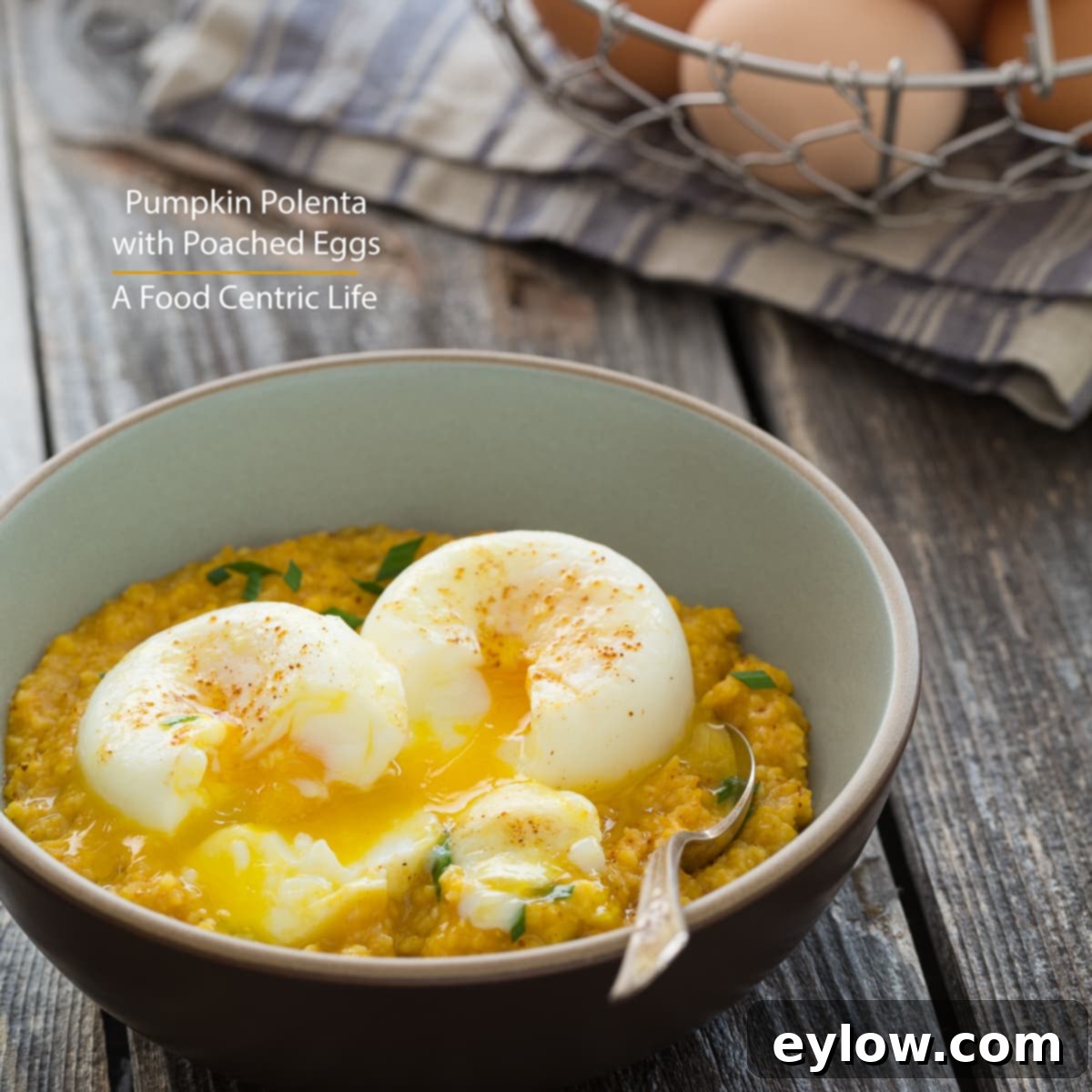Creamy Cheesy Polenta with Perfect Poached Eggs: The Ultimate Comfort Food Recipe
Indulge in a truly comforting and satisfying meal with our recipe for creamy, rich cheesy polenta topped with perfectly poached eggs. This delightful dish combines the rustic charm of traditional Italian polenta, made luxurious with sweet butter and savory Parmesan cheese, with the delicate texture and protein boost of perfectly poached eggs. It’s a meal that feels both wholesome and indulgent, making it an ideal choice for a hearty breakfast, a leisurely brunch, or even a comforting dinner. One of the best parts? The polenta can be prepared in advance and easily reheated, allowing you to enjoy this flavorful, cozy dish whenever the craving strikes.
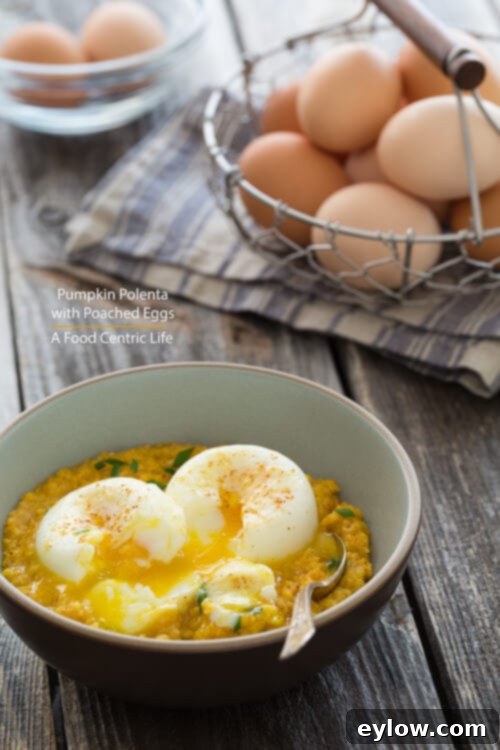
Polenta, a staple in Northern Italian cuisine, is a wonderfully versatile dish made from coarse ground cornmeal. It shares a comforting, creamy texture with its Southern American counterpart, grits, though they originate from different varieties of corn. My personal journey into mastering cheesy polenta began after memorable trips to San Francisco and Austin, where I savored various renditions of polenta and grits for both breakfast and lunch. These experiences ignited a passion, leading me to experiment with and perfect my own cheesy polenta recipe at home. This savory “porridge” isn’t just for breakfast; it also makes an excellent, wholesome “breakfast-for-dinner” option. For a delightful seasonal twist, especially in the fall, consider adding canned pumpkin puree for extra flavor, color, and nutrition!
Why You’ll Love This Cheesy Polenta and Poached Eggs Recipe
- Effortless Comfort Food: Despite its gourmet appeal, this dish is surprisingly easy to prepare, making it a perfect weeknight meal or a relaxed weekend treat. The simple steps yield maximum flavor and comfort.
- Incredibly Versatile: Enjoy cheesy polenta and poached eggs for any meal of the day. It’s equally fantastic for a substantial breakfast, an elegant brunch, a satisfying lunch, or a cozy dinner. Pair it with different sides to suit the occasion.
- Customizable Cheese Choices: Don’t limit yourself to just Parmesan! This recipe is incredibly adaptable, allowing you to experiment with a wide array of cheeses to match your taste preferences, from sharp cheddar to creamy goat cheese.
- Seasonal Pumpkin Addition: Embrace the flavors of autumn by incorporating canned pumpkin puree into your polenta. This not only adds a lovely earthy sweetness and a beautiful hue but also boosts the nutritional content. Alternatively, it’s just as delicious without it!
- Naturally Gluten-Free: Polenta is inherently gluten-free, making this dish a fantastic and safe option for those with gluten sensitivities or dietary restrictions, without compromising on flavor or texture.
- Make-Ahead Friendly: The polenta can be cooked in advance and stored, then gently reheated with a splash of liquid to regain its creamy consistency. This saves valuable time, especially for busy mornings or dinner preparations.
Essential Ingredients for Cheesy Polenta and Poached Eggs
Crafting the Perfect Cheesy Polenta: Key Ingredients
- Onion: Essential for building a foundational savory flavor in the polenta. Yellow, brown, white, or sweet onions will all work beautifully, caramelizing gently to release their aromatic sweetness.
- Garlic: Adds an extra layer of robust flavor. While optional, a few cloves of finely minced garlic truly elevate the depth of the polenta.
- Broth (Chicken or Vegetable) or Water: The liquid base for cooking the polenta. Using broth adds significantly more flavor than just water, enhancing the overall richness of the dish.
- Polenta or Coarse Cornmeal: The star of the show. I prefer using yellow, stone-ground organic cornmeal for its authentic texture and richer flavor. Ensure it’s coarse-ground for the best creamy consistency with a slight bite. Good quality polenta makes a noticeable difference.
- Cheese: Grated Parmesan cheese is a classic choice, lending a salty, umami depth. However, feel free to experiment with other melting cheeses like cheddar, Gruyère, or Monterey Jack for different flavor profiles.
- Butter: Unsalted butter is incorporated at the end to add richness, a subtle sweetness, and an incomparable velvety texture to the finished polenta. It’s crucial for achieving that truly comforting creaminess.
- Milk: While broth is the primary liquid, adding milk (or half milk, half broth) is a fantastic way to achieve an even creamier, richer polenta. Full-fat milk will give the most luxurious results.
- Salt and Pepper: Essential seasonings to enhance all the flavors in the polenta. Adjust to taste.
Achieving Flawless Poached Eggs: Simple Ingredients
- Eggs: Fresh, large eggs are paramount for perfect poached eggs. Fresher eggs hold their shape better, resulting in neater, more appealing poached whites around a runny yolk.
- White Vinegar (Optional): A splash of white vinegar in the poaching water can help the egg whites coagulate faster and more tightly, preventing them from spreading too much.
For precise measurements of all ingredients, including salt and pepper, please refer to the detailed recipe card at the bottom of this article.
Elevate Your Meal: Substitutions and Variations for Polenta and Eggs
- For Ultra-Creamy Polenta: Achieve an even more decadent texture by replacing half of the broth with whole milk. The added fat and dairy proteins contribute to an incredibly smooth and luxurious polenta.
- Pumpkin Puree Boost: For a seasonal twist, especially during autumn, stir in 1 cup of canned pumpkin puree (not pumpkin pie filling!) at the end of the polenta cooking process. It adds a beautiful color, a hint of earthy sweetness, and extra nutrients, making the polenta even creamier.
- Cheese Exploration: Expand beyond Parmesan! Experiment with grated Gruyère for nutty notes, sharp cheddar for a bold tang, Monterey Jack or Jalapeño Jack for a mild kick, Fontina for incredible meltiness, rich cream cheese for extra tang and creaminess, smoked Gouda for a smoky depth, or tangy goat cheese for a distinct flavor profile. Most good melting cheeses will work wonderfully.
- Aromatic Herbs: For a more profound savory flavor, infuse your polenta with dried herbs. A half teaspoon of dried sage or rosemary, added with the broth, will lend a wonderful fragrance and taste that complements the cornmeal and cheese.
- Protein Power-Up: To make this dish even more substantial and special, consider adding ribbons of thinly sliced Prosciutto or crispy ham on top of the polenta before adding the poached eggs. The salty, savory meat pairs beautifully with the creamy polenta and runny yolks.
- Alternative Protein Toppings: If poached eggs aren’t your preference, or you’re looking for another option, serve the cheesy polenta with cooked chicken sausage links, sliced and browned. The savory sausage provides a hearty and flavorful alternative.

Step-by-Step Recipe Instructions for Cheesy Polenta and Poached Eggs
Preparing this comforting meal is straightforward, ensuring delicious results every time. Here’s how to create your perfect cheesy polenta and flawlessly poached eggs:
Begin by finely chopping your onion and garlic. In a heavy-bottomed pot, such as a Dutch oven, heat a tablespoon of olive oil over medium-low heat. Add the chopped onion and cook gently, stirring occasionally, until it becomes soft and translucent, typically about 3-5 minutes. Be careful not to brown it. Next, add the minced garlic and cook for another minute until fragrant. Pour in the broth (and milk, if using for extra creaminess) and bring the liquid to a gentle boil. This is a crucial step to ensure the polenta cooks evenly.
Once boiling, slowly and steadily pour in the coarse cornmeal while continuously whisking. This whisking action is key to preventing clumps from forming and ensuring a smooth, creamy polenta. After all the cornmeal is incorporated, reduce the heat to low, cover the pot, and let it simmer for approximately 20 minutes. Stir the polenta occasionally throughout this period to prevent it from sticking to the bottom of the pot and to ensure even cooking. The polenta is done when it has achieved a creamy consistency with a slight “bite” – meaning it’s tender but not mushy. If the polenta becomes too dry or thick during cooking, simply stir in a splash of hot water, milk, or more broth until it reaches your desired creaminess. Finally, remove the pot from the heat and stir in the unsalted butter and grated cheese until fully melted and incorporated. Keep the polenta warm while you prepare your poached eggs.
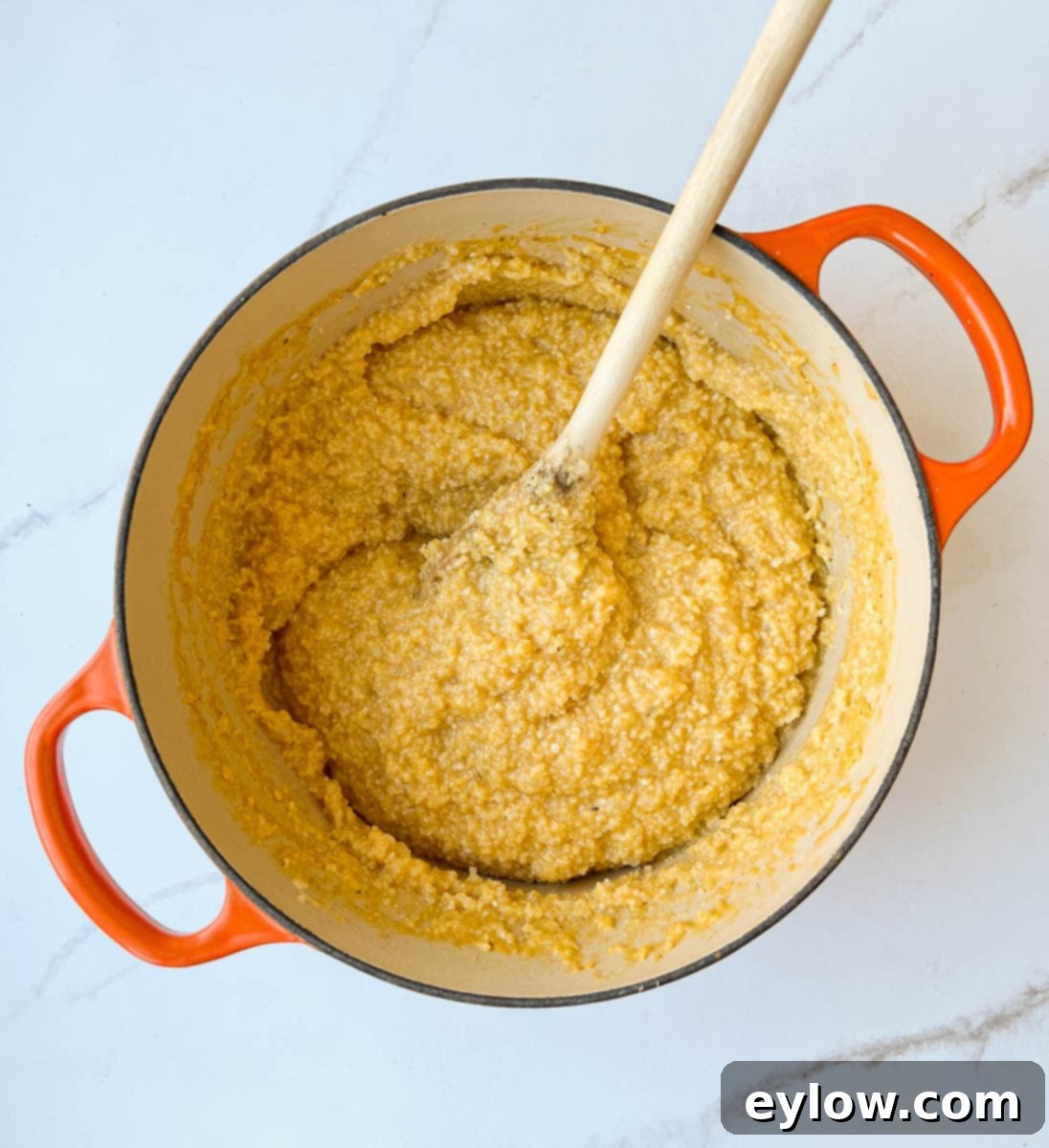
Mastering the Art of Poaching Eggs: Methods and Tips
Achieving a perfectly poached egg can sometimes feel like a culinary challenge, but with the right technique, it’s absolutely attainable. I’ve experimented with numerous methods over the years, some yielding beautifully consistent results, others leaving me with ragged egg white tendrils floating in the water. My pursuit of the “clean” poached egg has led me to a few reliable strategies.
The Classic Poached Egg Method: Tips for Success
The standard method involves bringing a pot of water to a gentle simmer, adding a dash of white vinegar (which helps the egg whites set faster), creating a gentle swirl in the water, and then carefully dropping a cracked egg into the vortex. While this can work, it often results in “shaggy” egg whites that separate and float freely, rather than forming a neat package around the yolk.
One Key Improvement: A trick I’ve found significantly improves the outcome is to first crack your egg into a fine-mesh strainer. Allow the very watery outer part of the egg white to drain off for about 30 seconds. This leaves behind the thicker, more cohesive part of the white, which will set much more neatly when introduced to the simmering water. After draining, gently slide the egg into the simmering, vinegar-infused water. This small step makes a big difference in presentation.
I’ve also tried specialized poaching bags, which resemble coffee filters, with mixed results. They can contain the egg, but the texture isn’t always ideal, and they often don’t deliver the pristine shape I prefer.
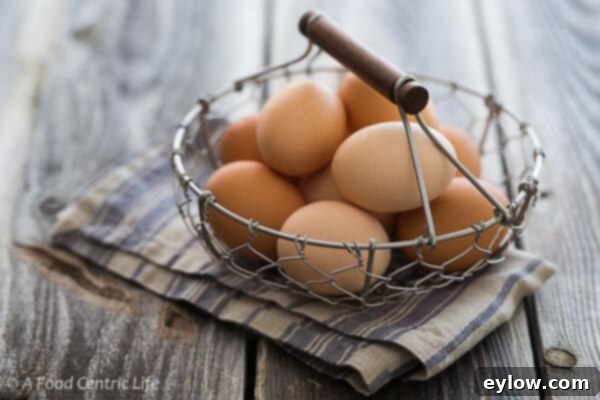
Effortless Perfection: Poaching Eggs with a Poaching Pan
For consistent, perfectly round poached eggs with minimal fuss and no messy egg white tendrils, a dedicated egg poaching pan with a non-stick insert is my go-to tool. These pans typically come with a lid and an insert featuring four to six individual non-stick cups. This method consistently delivers beautifully shaped eggs with runny yolks and perfectly set whites.
Here’s the simple process: Fill the poaching pan about halfway with water and place the non-stick insert into it. Crucially, spray each non-stick cup with a little extra non-stick cooking spray – think of it as insurance, even for supposedly non-stick surfaces, as eggs can be notoriously clingy. Place the lid on the pan and bring the water to a strong simmer. Once simmering, crack one egg into each prepared cup. Replace the lid and poach the eggs. For a softly runny yolk with set whites, I find 3 ½ to 4 minutes is the ideal cooking time after the lid is placed. This method guarantees perfectly round poached eggs every single time, making it incredibly easy and mess-free. These pans are widely available at cooking stores and online and are a worthwhile, inexpensive investment for any poached egg enthusiast.

Serving Suggestions and Storage Tips for Leftover Polenta
Once your cheesy polenta is ready and your eggs are perfectly poached, it’s time to assemble your delicious meal. Divide the warm, creamy polenta among shallow bowls, creating a comforting base. Gently place one or two perfectly poached eggs on top of each serving. For an alternative, or an extra protein boost, you can also top the polenta with slices of browned chicken sausage, as mentioned in the variations section. Finish your dish with a sprinkle of freshly chopped herbs, such as chives or parsley, for added freshness and color, and an extra grating of Parmesan cheese for good measure. This dish pairs wonderfully with a simple green salad for a balanced meal.
Leftover cheesy polenta can be stored in an airtight container in the refrigerator for 3 to 5 days. It tends to stiffen considerably when chilled, but don’t worry – it reheats beautifully, regaining its creamy texture with a little care. Having prepared polenta on hand makes for a quick and flavorful meal any time you need it.
Freezing and Reheating Cheesy Polenta for Future Meals
Cheesy polenta is an excellent candidate for freezing, making it perfect for meal prepping. I recommend freezing it in individual or two-serving portions in airtight, freezer-safe containers for up to 3 months. Always label and date your containers for easy tracking. When you’re ready to enjoy your frozen polenta:
- Thaw Overnight: For the best results, transfer the frozen polenta from the freezer to the refrigerator and allow it to thaw overnight. This ensures even reheating.
- Reheat on Stovetop: Scoop the thawed polenta into a saucepan. Heat it gently over low to medium-low heat, stirring frequently. As it heats, it will begin to soften. To restore its creamy consistency, gradually whisk in splashes of water, milk, or broth until it reaches your desired texture.
- Stir in Fresh Butter or Cheese: To bring back that freshly made flavor and richness, stir in a knob of butter or a fresh sprinkle of grated cheese at the very end of the reheating process. This simple step revitalizes the polenta.
Frequently Asked Questions About Cheesy Polenta and Poached Eggs
Cheesy polenta is a wonderfully versatile base. Beyond poached eggs, it pairs beautifully with roasted vegetables like asparagus or mushrooms, grilled meats such as steak or chicken, or sautéed greens. I also love topping it with quickly browned, sliced cooked chicken sausage for a hearty meal. A fresh green salad provides a nice contrast to the richness.
Absolutely! To make this polenta recipe vegan or dairy-free, simply use vegetable broth or water (vegetable broth will offer more flavor) as your liquid. Replace dairy butter with a high-quality plant-based butter, and opt for your favorite plant-based grated cheese alternatives. The result will still be wonderfully creamy and flavorful.
The best cheeses for polenta are those that melt well and contribute a rich, savory flavor. Classic choices include Parmesan, Asiago, or Pecorino Romano. For variety, consider Gruyère for a nutty flavor, sharp cheddar for a tangy kick, Monterey Jack or Jalapeño Jack for a mild spice, Fontina for its incredible melt, or even crumbled goat cheese for a tangy, creamy contrast. Experiment to find your favorite!
For authentic Italian polenta, look for coarse-ground or stone-ground cornmeal, typically labeled as “polenta.” Instant polenta is an option for quicker cooking, but it often lacks the texture and depth of flavor of traditional varieties. Yellow cornmeal is most common, but white polenta is also available and offers a slightly milder flavor.
To achieve the creamiest polenta, use a combination of broth and milk as your cooking liquid. Stirring frequently during the cooking process is essential to prevent sticking and break down the cornmeal evenly. Whisking continuously when adding the cornmeal to the boiling liquid will prevent lumps. Finally, don’t skimp on the butter and cheese at the end; they are key to its luxurious texture.
Discover More Cheesy Delights: Related Recipes
Cheese makes everything better! If you enjoyed the cheesy goodness of this polenta, you’ll love exploring these other delectable recipes featuring cheese to add flair and flavor to your meal times. Each offers a unique way to enjoy the versatility and richness that cheese brings to the table.
- Best Ricotta Cheese Filling Recipe
- Spinach Stuffed Mushrooms With Parmesan Cheese
- Roasted Broccoli and Parmesan
- Zucchini Gratin with Parmesan Crust
Share Your Experience: Rate This Cheesy Polenta Recipe
If you’ve had the pleasure of making this creamy cheesy polenta with poached eggs, we would love to hear from you! Your comments and feedback are incredibly valuable, and we enjoy learning about your culinary adventures. If you loved this recipe, please consider leaving a 5-star rating. Your ratings genuinely help other readers discover and enjoy this delicious comfort food!
📖 Delicious Cheesy Polenta & Poached Eggs Recipe
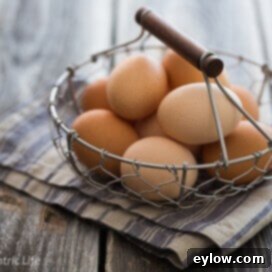
Cheesy Polenta with Poached Eggs
Sally Cameron
Pin Recipe
Equipment
-
A heavy pot like a Dutch oven with a lid 3 ½ quart size
Ingredients
Cheesy Polenta
- 1 tablespoon olive oil
- ¾ cup finely chopped onion
- 3 cloves garlic finely chopped
- 2 cups broth chicken or vegetable
- 2 cups milk
- 1 cup polenta or coarse cornmeal
- ½ cup grated parmesan cheese see cheese options below
- ¼ teaspoon salt
- ¼ teaspoon ground black pepper or white pepper
- 3 tablespoons unsalted butter
Poached Eggs
- 6 large eggs
Garnishes and Options
- 1 cup canned pumpkin puree optional
- 2 teaspoons chopped fresh parsley or chives as garnish optional
- ½ teaspoon dried sage or rosemary mixed in with the broth
- 4 tablespoons toasted pumpkin seeds Recipe on this site
Instructions
Make Polenta (grits)
-
Add olive oil to a medium-sized, heavy-bottomed pot (like a Dutch oven). Heat over medium-low heat until warm. Add the finely chopped onion and cook, stirring occasionally, until it becomes soft and translucent, which should take approximately 3 minutes. Be careful not to let the onion brown too much. Incorporate the finely chopped garlic and cook for another minute until fragrant.
-
Pour the broth (and milk, if using for extra creaminess) into the pot and bring the liquid to a gentle boil. This ensures a consistent cooking temperature for the cornmeal. Slowly add the polenta or coarse cornmeal in a steady stream, whisking vigorously and continuously to prevent any lumps from forming. Reduce the heat to its lowest setting, cover the pot, and allow the polenta to simmer for approximately 20 minutes. Stir the polenta several times during this period to ensure it cooks evenly and doesn’t stick to the bottom of the pan. If the polenta appears or feels too dry during cooking, simply add an additional ¼ cup of hot water, milk, or broth and stir until it reaches a creamier consistency.
When the polenta is nearly finished, taste a small amount to assess its texture. It should be delightfully creamy, with a slight “bite” from the coarseness of the grain. Adjust with more liquid if necessary to achieve your preferred creaminess. Once perfected, remove the pot from the heat and stir in the unsalted butter and grated Parmesan cheese until both are fully melted and smoothly incorporated. Keep the polenta warm while you proceed to poach the eggs.
Poach eggs
-
While the polenta is staying warm, prepare your poached eggs. Fill a poaching pan (or a regular pot if using the strainer method) halfway with water. If using a poaching pan with a non-stick insert, spray each egg cup generously with non-stick cooking spray. Place the lid on the pan and bring the water to a strong simmer. Carefully crack one large egg into each prepared cup. Place the lid back on the pan and poach the eggs. For medium-poached eggs with beautifully soft, runny yolks and set whites, they will typically take approximately 3 ½ to 4 minutes once the lid is covered. Adjust cooking time for your preferred doneness.
Serve
-
Ladle approximately ¾ cup of the creamy cheesy polenta into individual shallow bowls. Carefully top each serving of polenta with one or two perfectly poached eggs. For an optional fresh finish and a pop of color, sprinkle with freshly chopped chives or parsley. Serve immediately and enjoy this ultimate comfort food!
Notes
Pumpkin Option: If you’re adding canned pumpkin puree for extra flavor and creaminess, stir in ½ cup of pumpkin puree at the very end of the cooking process, along with the butter and cheese. Heat it through gently until well combined and warm.
Reheating Cheesy Polenta: Polenta will stiffen significantly when refrigerated. To restore its creamy consistency for reheating, transfer it to a pot and gradually stir or whisk in milk, water, or broth over low heat until it becomes smooth and creamy again.
Nutrition Note: The provided nutrition calculation in the recipe card is for the cheesy polenta itself and does not include the poached eggs. For reference, two large poached eggs typically contribute approximately 10 grams of fat, 12 grams of protein, and about 187 milligrams of cholesterol to your meal. Please factor this into your dietary considerations.
